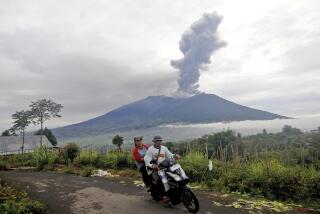On Japan’s Mt. Ontake volcano, a perfect day turns deadly for hikers
- Share via
Reporting from Tokyo — It was a perfect fall weekend, with sunny skies and the prospect of colorful autumn foliage. Hundreds of people flocked to Mt. Ontake in central Japan, planning to hike to its volcanic summit.
At 11:52 a.m. Saturday, authorities said, Mt. Ontake erupted without warning, spewing smoke and ash and, apparently, toxic fumes.
On Sunday, authorities said four hikers were confirmed dead and an additional 27 bodies were found on the mountain about 150 miles west of Tokyo.
At least 30 more people were injured, and a search and rescue crew including helicopters and about 300 people was dispatched to the area.
Naofumi Miyagi, spokesman with the Nagano prefecture police, said all 31 victims found lifeless showed signs of cardiopulmonary arrest; autopsies were conducted on four hikers who were brought down from the mountain Sunday afternoon.
Police refused to answer further questions on the possible causes of death. But Tomoyuki Kanno of the earthquake and volcano department at the Japan Meteorological Agency said two types of toxic fumes — hydrogen sulfide and sulfur dioxide — were detected in the summit area.
Amateur video uploaded by hikers showed a huge cloud of noxious ash suddenly pouring from the peak.
Rescue workers scaled the 10,000-foot peak via hiking trails, and it was unclear how many trips it may take to bring down the other 27 victims, said an official at the crisis management and disaster prevention division in Nagano, who requested anonymity because he was not authorized to make comments.
Kiyomi Ando, a press officer for the town of Kiso in Nagano, said 151 hikers were able to escape. Of those, about 40 descended from the area near the top of the mountain and an additional 120 people made it down after sheltering in a large cabin.
Of the injured, one person was in critical condition and 29 had moderate to light injuries, Nagano authorities said.
Further searches were planned for Monday, Ando said.
As one of the highest volcanoes in Japan, the mountain is a popular hiking destination, particularly for fall foliage. It is a three-hour hike to the top after a ride on an aerial lift. “Beginners can do the hike,” Ando said.
Mt. Ontake had a minor eruption in 2007 and a larger one in 1979.
Toshihiko Sawada, an official with the aerial lift, said Saturday had provided ideal weather for hiking, with clear skies. “We had more than the usual number of tourists and hikers,” he said.
Sawada said 660 people used the aerial lift services Saturday morning before the eruption.
Some tourists climb to the top from the lift stop, and others just walk around the top of the station area and then come down, Ando said.
“There was no warning of a volcanic eruption,” Sawada said. In the wake of the explosion, authorities raised the alert level from 1, or “normal,” to 3, meaning “restricted access.”
Kanno said Mt. Otake had a phreatic eruption, which happens when underground water is heated by magma and then hits a boiling point, causing an explosion.
“It’s often the case there’s no warning signs with those types of eruptions,” Kanno said.
Nagano is a special correspondent.
More to Read
Sign up for Essential California
The most important California stories and recommendations in your inbox every morning.
You may occasionally receive promotional content from the Los Angeles Times.













